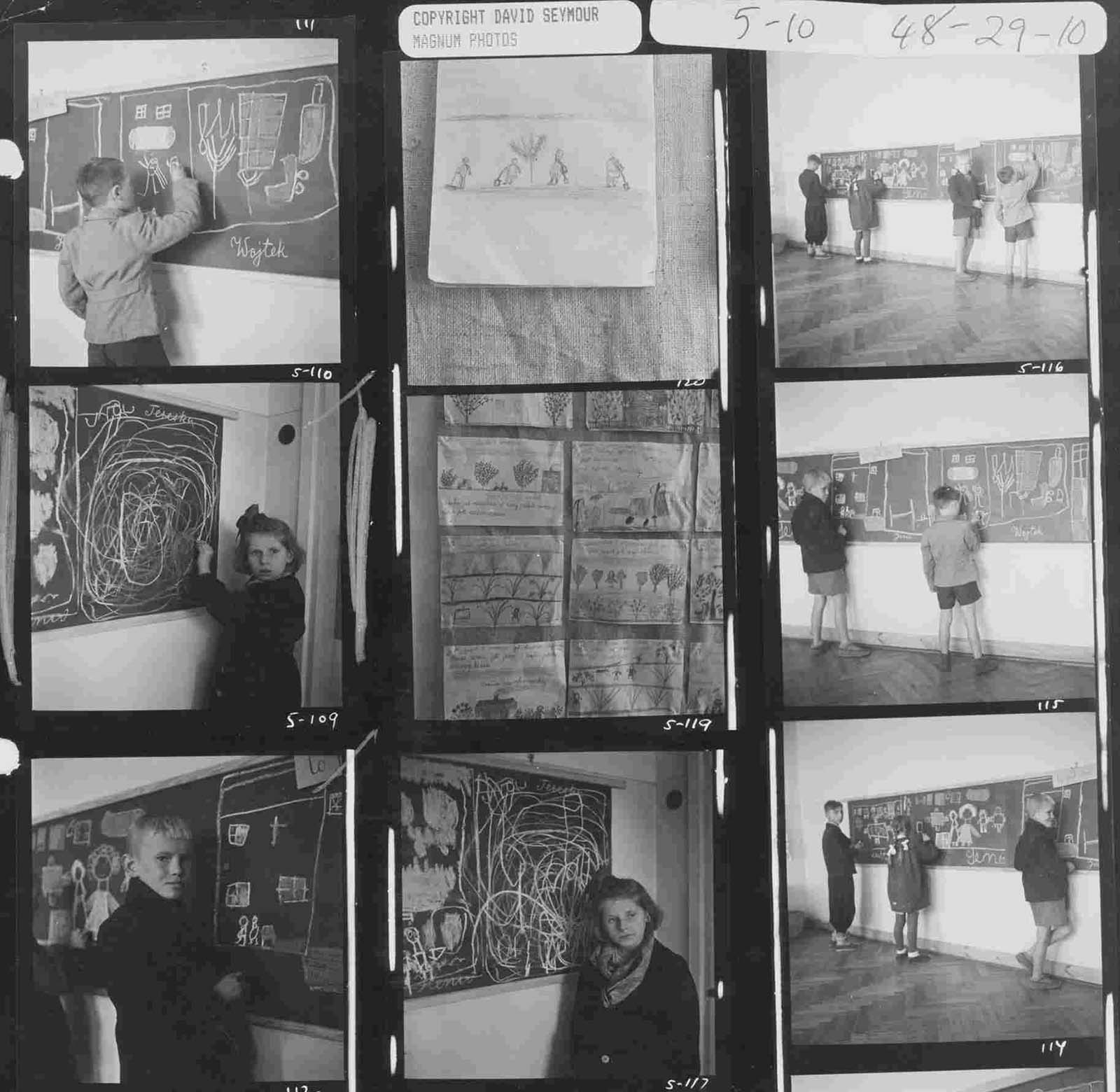
Tereszka, a child in a residence for disturbed children. She drew a picture of “home” on the blackboard. Poland, 1948.
This extraordinary picture taken in 1948 by David Seymour, one of Magnum Photos’ co-founders, has since been seen by millions.
First, it was published in LIFE magazine where the caption read in part “Children’s wounds are not all outward. Those made in the mind by years of sorrow will take years to heal.”
This image of Tereska drawing her home has fascinated many and has become emblematic of World War II. Her eyes are piercing, like a window to her soul.
Not the eyes of innocent youth. Like the soldiers who have seen heavy combat, she’s got the terrifyingly haunting one-thousand-yard stare.
For over 70 years this image was surrounded by mystery and the real identity and the real story of Tereska remained unknown.
There are other versions of this image circulating around, and in many cases, their captions mention that the subject grew up inside a concentration camp. However, that’s not the case.
Early in September 1948, David Seymour was sent by UNICEF as a special correspondent to report on children in five European countries.
He visited Italy, Greece, Austria, Hungary and his last stop being Poland, his native country. While visiting Poland, Seymour had found out that his parents and most of his family has been killed by the Nazis.
After traveling to Otwock, 25 miles from the capital, where he summered as a child, he went back to Warsaw, where he photographed the ruins of the Jewish ghetto.
There, Seymour chanced upon a group of schoolchildren pushing wheelbarrows full of rubble, and he followed them, finding several other children working on their garden plot as occupational therapy.

David ‘Chim’ Seymour’s photographs as they appeared in LIFE magazine in December 1948.
In a school for “backward and psychologically upset children,” as Seymour states in his story’s captions, Tereska, then seven or eight years old, is standing in front of a blackboard.
As we see in the photographer’s contact sheets from a pinned notice on the blackboard, the teachers’ assignment was ‘To jest dom”- “This is home”.
That is what children were supposed to draw, but Tereska could only trace in chalk a tangle of frantic lines. Her haunted eyes reflect her confusion and anguish.
Who was Tereska and what happened to her?
The school was the topic of a 1948 short film, where one can recognize in the classroom several elements present in David Seymour’s photographs: wooden floors, similar wall painting, a black trim painted on the wall, and a big round black metal buzzer placed near the door.
It is no longer a special-needs institute but has become Primary School no177 on Tarczynska street, in the Stara Ochota district.
Going through the Institute’s archives, three possible “Tereska” were identified from the 1948 class list. One of them was too old to be the girl in the image – she was 12 or 13. When the researchers saw family pictures of the second Tereska, it became obvious that it also wasn’t her.
The third Tereska was seven or eight, which tallied with the picture, and had left the school after a year. The research team was able to find her brother and sister-in-law and to piece together a few elements of her life.
Teresa Adwentowska came from a Catholic family. She was one of two daughters of Jan Klemens, who was an activist in the Polish Underground State, the Resistance.
During the Warsaw Uprising (August-October 1944), he was heavily beaten and all his teeth were broken by the Gestapo at their Warsaw headquarters and prison.
During the war, Tereska’s mother Franciszka did her best to make ends meet, for instance visiting the Jewish ghetto in order to trade goods.

Contact sheet of the children drawing on blackboard. Special-need institute, Warsaw, 1948.
During the bombing of Warsaw by the German Lutwaffe, Tereska’s home was destroyed, and her grandmother was most likely shot by Ukrainian soldiers who were helping the Germans annihilate the Warsaw Uprising. Tereska was struck by a piece of shrapnel that left her brain damaged.
Fleeing Warsaw after the bombings, four-year-old Tereska and her 14-year-old sister Jadwiga spent three weeks trying to reach a village forty miles away from Warsaw – on foot, in a war-ravaged country. They were starving.
That episode left her with an insatiable hunger, and her physical and mental condition steadily deteriorated.
During the 1954/1955 school year, she had to be sent to a mental asylum in Świecie (about 190 miles from Warsaw). Since her early childhood, she had loved drawing, mainly flowers and animals.
As a teenager, she got addicted to cigarettes and alcohol and became violent towards her younger brother.
Since the mid-sixties, she spent her life at the Tworki Mental Asylum near Warsaw; the only things that meant anything to her were cigarettes, food and her drawings.

Family album with Tereska’s photos. Courtesy of Krzysztof Siemiątkowski.
In 1978, at the Tworki Mental Asylum, Teresa Adwentowska met with a tragic death: she accidentally choked on a piece of sausage that she had stolen from another patient.
David Seymour’s photograph of Tereska has become a symbol of the fate of children during the war. As if caught in the tangled web of her own chalk lines, she remained frozen in time: for Tereska, war never ended.
(Photo credit: David Seymour / LIFE magazine / Carole Naggar).